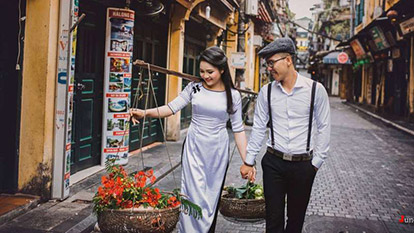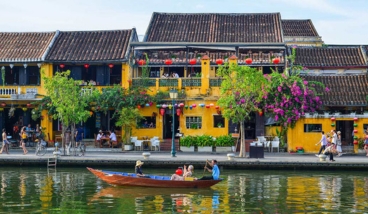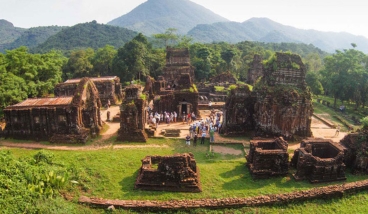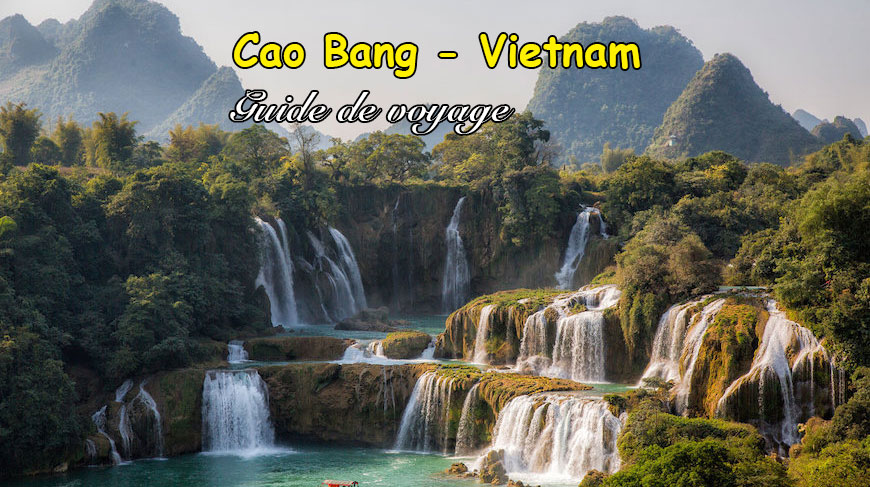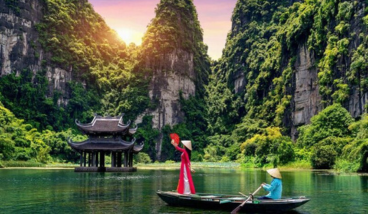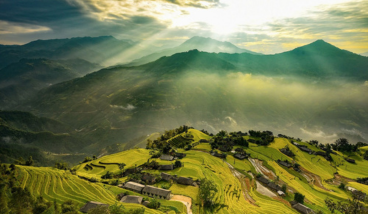Hue - Ancient capital
Hue is located in Thua Thien prefecture and is in the central part of Vietnam. Located 660 km from Ha Noi and 1080 km from Saigon, Hue has always been considered the fulcrum of Vietnam's two rice baskets, the Red river delta and the Mekong delta. Hue became the name of Vietnam's most well known ancient capital because of the local mispronunciation of the word Hoá in Thuân Hoá.

Since the 16th century, Thuan Hoa, due to its strategic location, has been a very prosperous area. The Nguyen Lord chose this area to be their headquarters. Nguyen Anh made it Vietnam's capital city in 1802 after he defeated the Tay Son and ascended to the throne with the name Gia Long. King Gia Long (1762-1819) was credited for building and fortifying Hue from the very beginning. Since then, successive king of the Nguyen Dynasty has added to the foundation set by his predecessors.
Attractions
Nine Dynasty Urns
There are nine greatest bronze urns in Vietnam placed in the shade of the Hien Lam pavilion, in front of the Mieu temple and southwest of the Royal citadel. They were cast by Emperor Minh Mang in 1836. After their casting, the Nine Dynastic Urns were placed in accordance with the altars in Mieu temple, at the position as today. The 17 relieves on each urn comprise what are most typical of the country from the Lang Song province to the Ca Mau cape.
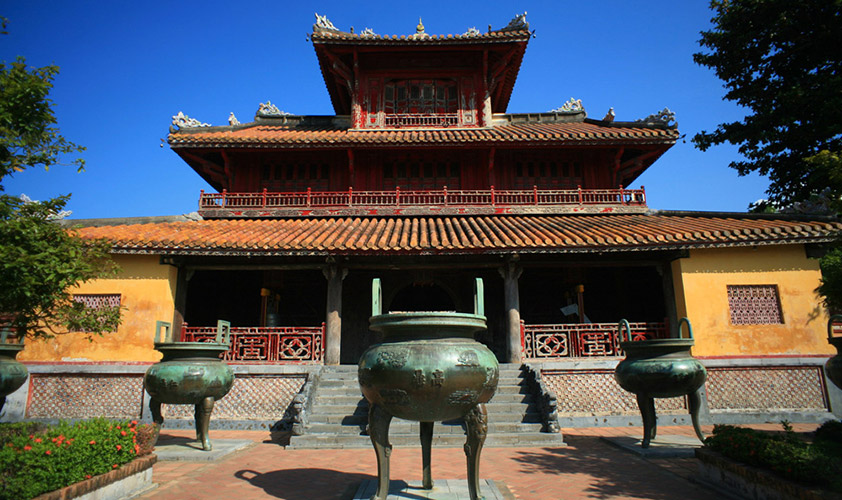
They are concentrated on the following themes: stars, mountains, seas and oceans, vehicles, valuable forestry and sea products of Vietnam early in the 20th century. The nine dynasty urns were cast by Minh Mang to symbolize the dynasty sovereignty. They are a cultural heritage , almost intact and rare in this harsh-weather and war-worn land.
Thien Mu Pagoda
The name of the pagoda takes its source from a legend. It was told that long ago, there appeared an old woman every night on the hill where the pagoda stands today. She told local people that a Lord would come and build a Buddhist pagoda for the country's prosperity. Lord Nguyen Hoang, on hearing that, ordered the construction of a pagoda of the Heavenly Lady.
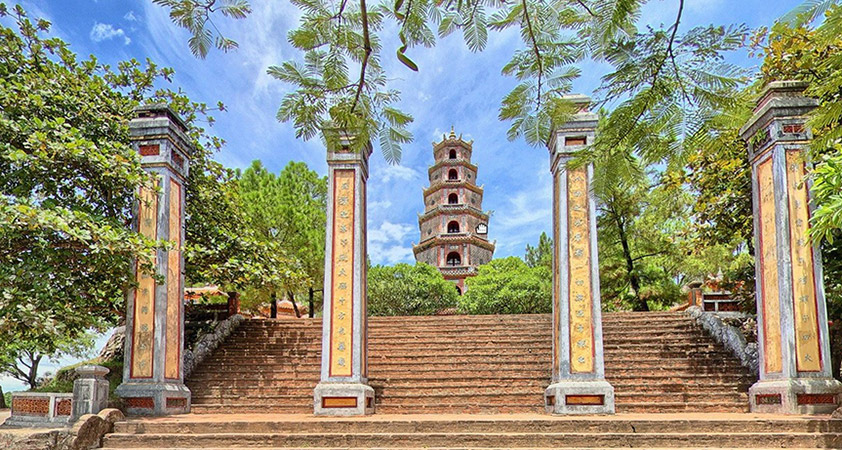
It was built in 1601, and then Lord Nguyen Phuc Tan had renovated in 1665. In 1710 Lord Nguyen Phuc Chu had a great bell cast (2.5 m high, weighed 3,285 kg) and a stele (2.58 m high) erected on the back of a marble tortoise in 1715. In the Nguyen Dynasty, Kings such as Gia Long, Minh Mang, Thieu Tri, Thanh Thai all had the pagoda restored. Phuoc Duyen tower (at first called Tu Nhan tower) was built in 1884 by King Thieu Tri. Phuoc Duyen tower has seven-stored with 21m high in octagonal shape.
Dai Hung shrine is a main-hall and a magnificent architecture. In the main-hall, besides the bronze cast statues, there preserved some precious antiquities: the bronze gong cast in 1677, the wooden gilded board with Lord Nguyen Phuc Chu's inscriptions in 1714. On the both sides of the pagoda there are a bonze's room and a guest-room for visitors. In front of the pagoda is flowers and ornamental plant. At the back is a calm and romantic pine-tree garden.
The pagoda was heavily damage in 1943. Priest Thich Don Hau has organized a great renovation of the pagoda for more than 30 years since 1945. Nowadays it becomes more and more magnificent and attracts tourist near and far.
Ngo Mon Gate
This three-story structure is 58 m long, 27.5 m wide, 17 m high and serves as the main entrance to Imperial city. There are five gates to Ngo Mon, with the central gate being reserved for the kings only. The two adjacent gates were exclusively for court officials, and the two other outer gates were used for servants and members of the royal entourage. On top of the arch in the Five Phoenix Tower where the king sat during festivities.
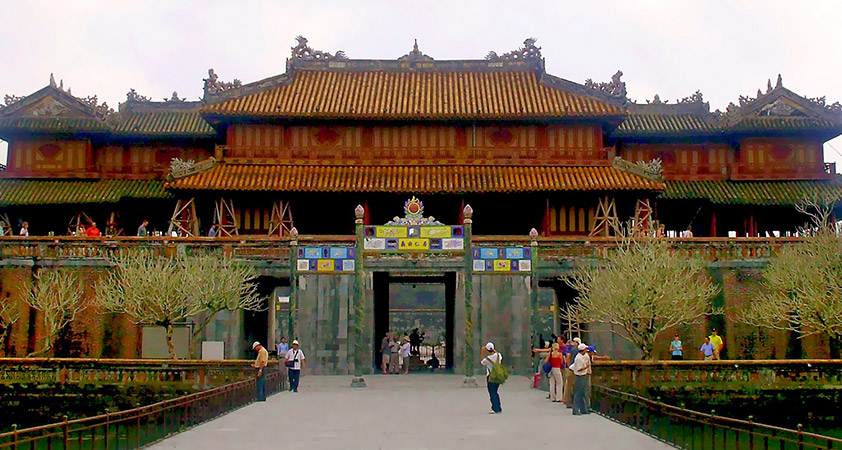
This was also where ceremonies were organized to announce the names of successful candidates of royal examinations. During the reign of the Nguyen Kings, Ngo Mon Gate was only opened when the kings were passing by or receiving foreign ambassadors.
Throne Palace
Throne palace, the building for great court's meetings, faces the Noon gate and lies right on the axis piercing the centre of the Royal citadel. It was constructed in 1805 by Emperor Gia Long and used later in 1806 for his coronation. In 1833 it was moved onto a foundation of 2.33m high as now by Emperor Minh Mang. It is 44m long, 30.5m across, 11.8m high and contains a 5-compartment, two-bay main building connected with a 7-compartment, two-bay front building.
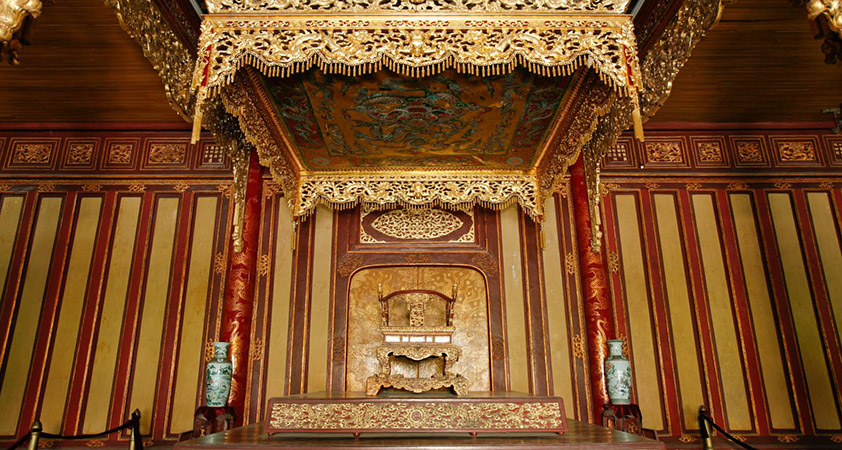
The columns are lacquered red and decorated with golden dragon designs. On the roof ridge rest two dragon designs paying homage to a moon. Eaves and roof corners are ornamented with head-turning dragon designs. These and the moldings along the eaves are inlaid with multicoloured ceramic chips. The roof is covered with yellow enameled tiles. Constructors of the Throne palace have created two contradictive features: cool inside in summer and warm in winter. Throne Palace is the site where solemn ceremonies took place such as: the Coronation Day, the Crown Prince Coronation Day, Emperor's Birthday Anniversaries, etc.
Hue's Museum Of Antiquity
Hue's Museum of Antiquity is a gallery displaying collections of bronzeware, ceramics, chinaware, furniture, royal costumes and personal belongings from former Vietnamese emperors.
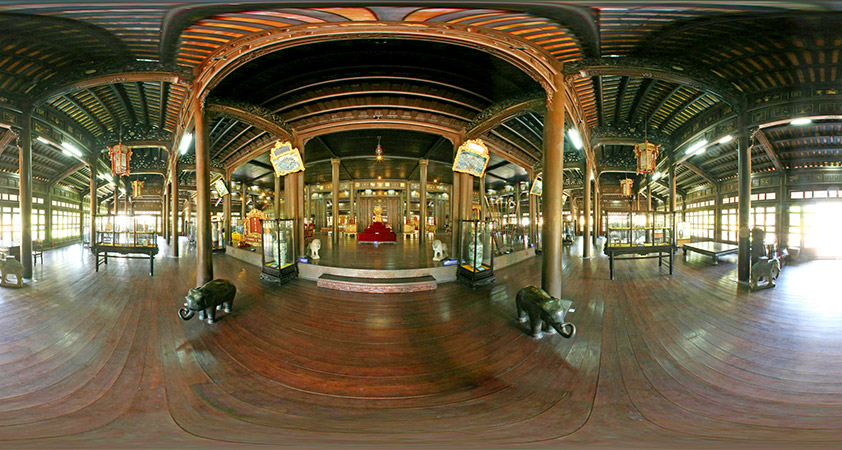
Now located at 3 Le Truc Street, the museum was built in 1845 by Emperor Thieu Tri. The elegant building, initially called Long An Palace, was dismantled and rebuilt in 1909 at its present location to serve as a library and office. This building is a monument of remarkable value. It contains some wooden panels that are inscribed with poems and essays written by Emperor Thieu Tri himself.
Trang Tien Bridge
Spanning the Huong river there are more than ten bridges but only one becomes Hue symbol, that's Trang Tien bridge.
As written in Annual of Unified Great Nam by " The office of Vietnam History" of the Nguyen Dynasty, "the metal bridge Trang Tien in the south east of the Capital commenced to be built in the 9th year of King Thanh Thai (1897) and then finished in 1899. The bridge is about 400m long with 6 spans". In August 1904, a terrible typhoon devastated the Center of Vietnam, and 6 spans of the bridge were broken down, only two spans remained. In 1906 the bridge was reconstructed. Trang Tien bridge has been repaired so many times again. Near the bridge right gate there was once a small market at the Trang Tien wharf, named Dong Ba. Nowadays Dong Ba is a trading center of Hue city.
Huong River - Ngu Mountain
The Perfume river, Huong Giang in Vietnamese, has two main sources in the Truong Son mountains: the Ta Trach and Huu Trach rivers. It is 30 km long and features and extremely slow current as the water is at almost the same level as the sea. The river runs through the village of Kim Long, Nguyet Bieu, Vy Da, Dong Ba, Gia Hoi and Bao Vinh. The view on both sides is magnificent with the citadel, gardens, pagodas, towers and temples; their reflection on the water makes the river even more poetic.
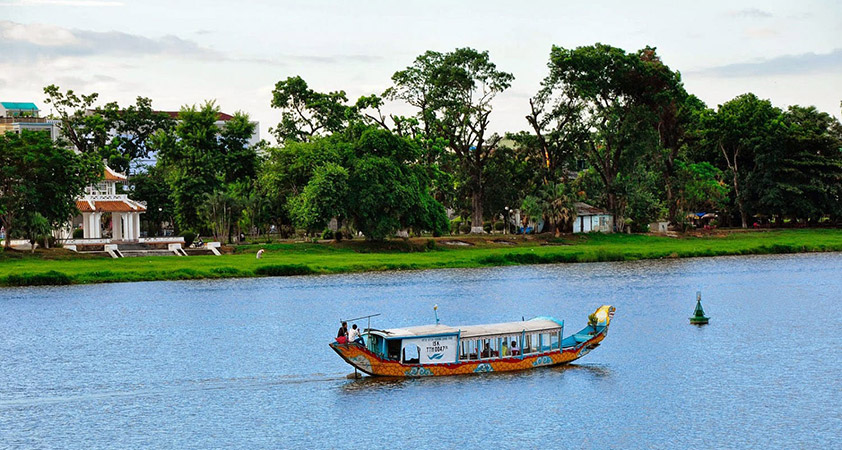
Many locals think that Hue has such peaceful, gentle and tranquil landscapes because of the Perfume river. Ngu Binh mountain's imposing and symmetrical outline is surrounded by Ta Bat Son and Huu Bat Son mountains. During the Nguyen Dynasty, emperor Gia Long built the capital of Hue next to Ngu Binh to use it as a shield. Hue's landscape is magnificent surrounded with the Perfume (Huong) river and Ngu Binh mountain. The oil capital is even sometimes called Huong-Ngu city.
Hue National School
Quoc Hoc high school was founded pursuant to the royal decree dated September 17th 1896 and the decree on November 18th 1896 of the French Resident-Superior in Indochina. The school was built on the site of a former squadron headquarter - a royal navy headquarters.
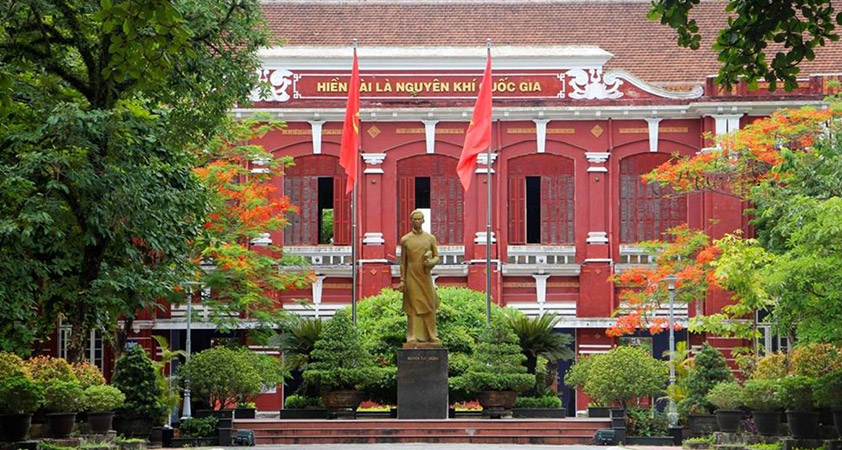
In 1915 when the decree annulling Emperor ancient exam in the province and the ancient exam of the capital in the North was issued, Quoc Hoc high school was rebuilt. The rows of thatch roofed apartments were torn down and replaced by two rows of buildings, the wall made of brick, the roof covered with tiles. It was solid and comfortable according to the western European architecture. Most of the architectures are still extant.
Temple Of Letters
The Temple of Letters is a worship temple founded by the Nguyen dynasty to dedicate to celebrated scholars of Confucianism. Its construction was built in 1808 on a low hill beyond the Thien Mu pagoda, on the left bank of the Huong river. All items of Hue Temple of Letters were erected on a square surface of 160m long on each side enclosed by La Thanh ( surrounding wall). There was once a complex of 50 big and small constructions including 32 steles which bore names of doctors and four other steles.
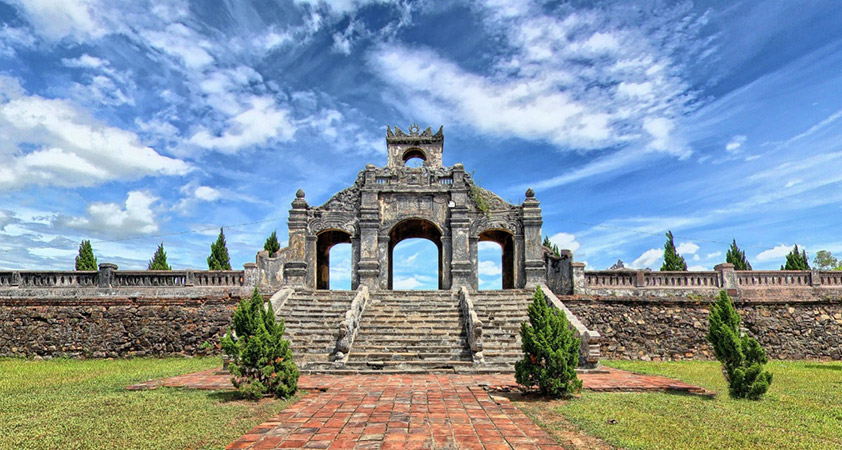
The Temple of Letters was many times renovated and many sub-constructions were built, especially in Minh Mang and Thieu Tri's time. Hue Temple of Letters is a valuable historic remains. To visit Van Mieu, tourists can understand more about the tradition of knowledge appreciation, scholars administration and study encouragement of our ancestors from the old time.
Thanh Toan Tile-Roofed Bridge
Thanh Toan tile-roofed bridge crosses a canal flowing from the beginning to the end of Thanh Toan village, Thuy Thanh commune, Huong Thuy district. The village is about 8km from Hue city on the eastward.
This is an arched wooden bridge, 17m long and 4m wide. On both sides of the bridge length are 2 rows of wooden platforms and parapets for people to lean their backs. The tile-roofed Thanh Toan bridge is not only an ancient architectural remain with highly historic and cultural values but also a tourist attraction.
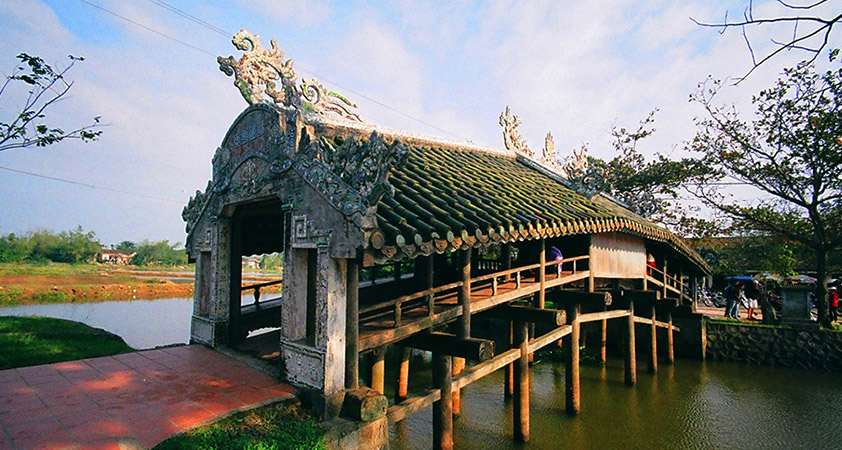
The bridge was built over 2 centuries ago and damaged many times by storms, floods and wars. In September 1991, the bridge was greatly renovated according to the old design and officially accepted by the Cultural Ministry as a national remains, a rare and appreciated beauty-spot of the whole country.
Hon Chen Temple
Standing just on the bank of the Huong river inclined to poetic dreams and 10km upstream of Hue, the Hon Chen temple for cult of Po Nagar, the Goddess of the ancient Cham minority. After then, the Vietnamese continued the cult and name the Goddess as Heaven Goddess Y A Na.
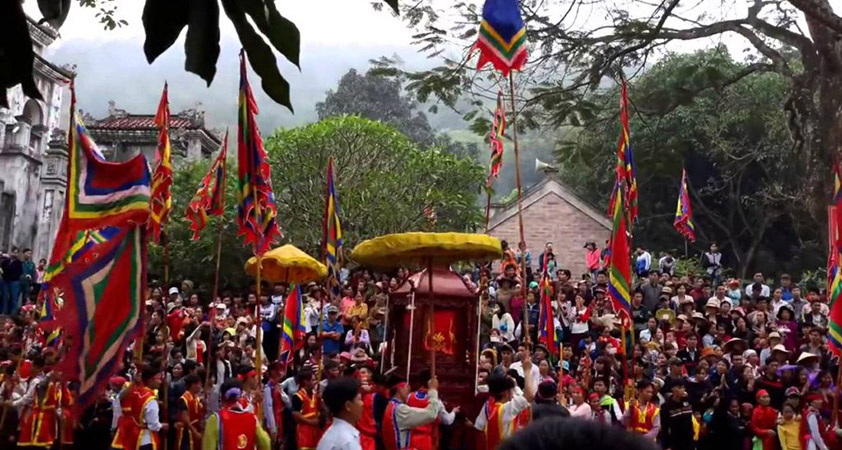
This temple for Goddess appeared in this place centuries ago, but with a very simple design, and after then, reconstructed with a larger and more beautiful architectural scale in 1886. The Hon Chen temple is situated at a lovely site seated on the slope of the mountain Ngoc Tran with sheer cliff and mirroring in the deep blue water of the Huong river.
Nguyen Kings' Tombs
There are eight royal tombs in Hue, being the final resting places of the Nguyen Kings. Construction of the tombs was very meticulous and started while the king was still alive. Most of the tombs face the southwest, direction of the Imperial city. Each toms consists of two complexes. The first is reserved for funeral services and the second one is exclusively for the toms. Generally, each tomb is enclosed in a surrounding rampart called "la thanh".
However, each tomb internal arrangement is different from one another; particular arrangements reflected each king's points of view, personality and tastes.
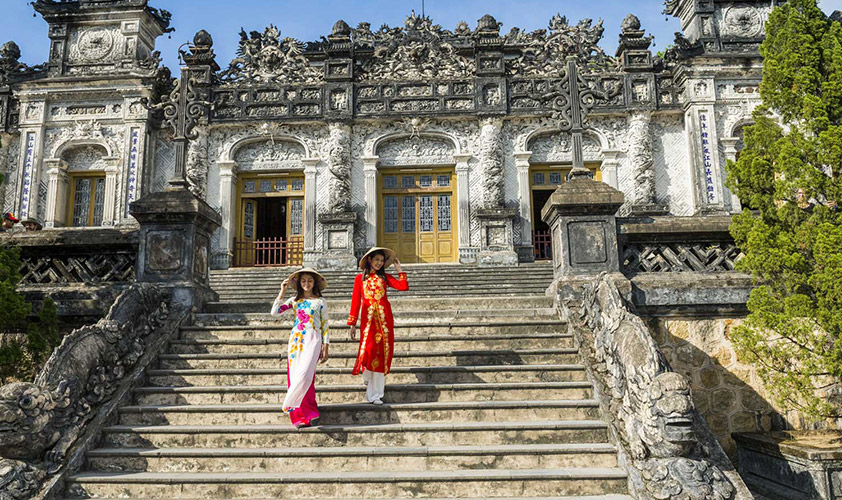
Tomb Of Minh Mang
The construction of the tomb of Minh Mang started in 1840 and was completed in 1843. It is located in an enclosed hilly area of 18ha in Cam Khe village, 12 km from the centre of Hue.
Minh Mang tomb is a standard architectural complex consisting of 40 big and small constructions which include palaces, temple, pavilions, etc., designed on symmetric axis along the Dai Hong gate outside to the foot of La Thanh behind the Emperor's tomb.
Visit to Minh Mang tomb, tourists fancy that they are wandering in a world of painting, poetry and philosophy - besides the strictness, majesty and symmetry of the architectural constructions. The tomb of Minh Mang has an air of magnificence and formality, and its architectural design harmoniously blends with its natural surroundings.
Tomb Of Tu Duc
The tomb of Tu Duc is situated on Duong Xuan mountain in Duong Xuan Thuong village, on the bank of the Perfume river, 8km from the centre of Hue.
The construction started in 1864 and was completed in 1883. Also called Tomb of Modesty, the necropolis complex is enclosed by a thick wall following the contour of the hill, among a pine tree forest. Tu Duc tomb is not only one of the most beautiful works of royal architecture of the Nguyen dynasty but also is a romantic picture of mounts and lakes.
Tomb Of Khai Dinh
The tomb was built between 1920 and 1931. It is located on top of the Chau E mountains, 10km of Hue. Located in a vast expanse of wilderness, Khai Dinh tomb looks like a magnificent palace perched on the slope of a limestone mountain. It is a accessible by climbing 109 stone steps.
Unlike the construction materials used for the other tomb, Khai Dinh mausoleum was built with modern materials such as steel and reinforced concrete. The peculiar feature of the tomb is the magnificent porcelain decorations on the walls, columns and ceilings.
Tomb Of Gia Long
The tomb of Gia Long is located 16km from the centre of Hue, on top of the Thien Tho mountain, on the west bank of the Huong river. Construction of the tomb began in 1814 and was completed in 1820. Located in a vast land covered with a wide canopy of old pine trees, the mausoleum was built according to a monumental but simple design.
In front is a lotus pond. Behind the pond is a large terraced yard divided into three different levels. The first level was used as the waiting area and is bordered by two rows of elephant and horse statues.
Tomb Of Dong Khanh
Dong Khanh tomb is located on the land of Cu Si hamlet, now Thuong Hai village, Thuy Xuan commune, Hue city. The tomb was built in 1917. The whole architecture of the tomb are divided:
The worship temple, in general, the constructions still bear the traditional figures : house with multi succeeding roofs. In the main temple and its dependent houses, the familiar splendid red and gilt pillars with decoration of four seasons and four Holly animals are still seen. Most noteworthy is Ngung Hy temple - the best conserved place of famous red and gilt arts, of famous lacquer arts of Vietnam.
The tomb area: the tomb design was almost completely Europeanized from the architectural peculiarity, decorative model to building materials - Bi Dinh is a variation of Romance architecture blended with Asian architecture with tall, thin mandarin statues from cement and bricks (instead of stone), tile and carreau bricks.
In general, Dong Khanh tomb was beginning of the mixture of European and Asian, of the old and new architecture.
Tomb Of Thieu Tri
Thieu Tri's tomb lies in Chu Chanh village, Thuy Bang commune, Huong Thuy district, about 8km from the city. The tomb was built in 1849 and divided into two parts: the tomb area and temple area.
The tomb area: on the right with Nhuan Trach lake is the bronze gate leading to big Binh Dai. The two rows of stone statues on the left and right of the court are typical for the sculpture in the first half of 19th century in Hue. Ngung Thuy lake looks like a crescent moon barring in front of Buu Thanh.
The temple area : after passing the marble gate and another three steps leading to Bieu Duc temple, tourists will go through Hong Trach gate. In the main temple there engraved over 450 word boxes including poems with education and literature values.
Thieu Tri's tomb lies there with simple and intimate beauty, leans its back against the foot of Thuan Dao mount, in front of the tomb stretches flat land with lushly green trees and rice-fields from the Huong river 's bank up to Lim bridge.
Bach Ma Park
Bach Ma National Park is located approximately 50 km north of Hue. In the 1930s, a city was located in the mountains, but it was almost completely destroyed after the 1946 - 1954 revolution. Nowadays, all that is left are the remnants of a city built with roman architecture and buried under vegetation. Bach Ma National Park is now considered as another Dalat, but in the centre of the country. The temperature never goes below 4°C in the winter and the hottest summer temperature does not exceed 26°C.

Bach Ma National Park has a lot to offer, as much in terms of sites to visit as landscapes to admire. From the top of Hai Vong Dai, the highest peak at 1,450 m, one can admire a fantastic view. The Grand Do Quyen Waterfall, over 300 m high and 25 m wide, is also impressive. Rich vegetation and animal-life also attract many visitors. The park is home to 233 species of birds and 55 species of mammals, as well as extensive flora of more than 500 species. Extensive scientific research is also carried out here.
Thuan An Beach
Thuan An beach is situated near by Thuan An mouth, where Huong river runs to Tam Giang lagoon and then to the sea.... In the beginning of the 19th century, King Minh Mang named the place as Thuan An, assigned to build Tran Hai frontier post for defense of the Capital. Far from Hue 15 km, only 15 minutes by car, tourists are able to reach the beach. Plenty small boats, junks drift up and down the river in the left of the route, and on the right there are houses, temples, pagodas, rice field and gardens successively spread out...
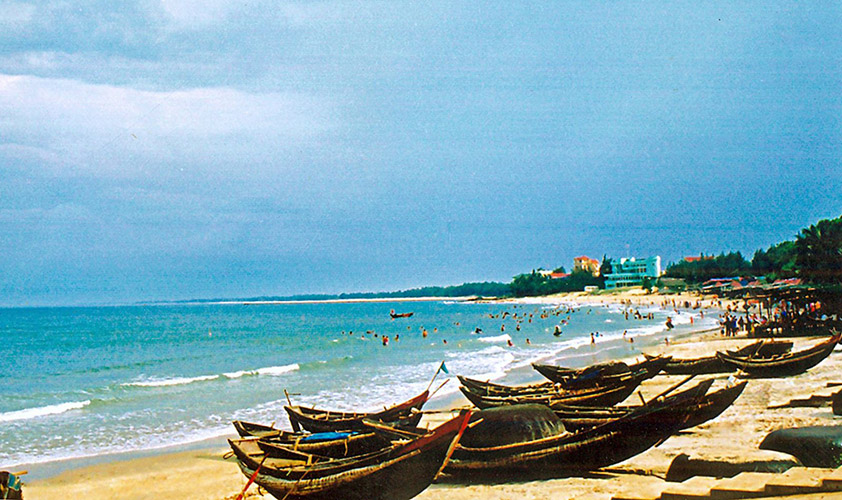
Thuan An is a very enjoyable place for all tourists after a full day to visit Citadel, mausoleums, pagodas and Hue scenery... Thuan An is also the place where Hue people gather to enjoy the fresh air and sea-bathing in summer time. Intensive activities of the beach lasts from April to September, while Hue temperature being fairly hot. Besides sea bathing, tourists are able to visit Thai Duong temple where Thai Duong Goddess is very esteemed by villagers or visit the temple devoted to the whale, the sacred animal of the local people.
Lang Co Beach
Leaning against the Truong Son mountains, Chan May cape is in the shape of an enormous crescent. It is next to Lang Co Beach and north of Hai Van Pass. These beaches are considered the nicest in the central area. Lang Co Beach is 10 km long with white sand and clean and shallow water. The in-season is from April to the end of July, with an average temperature of 25oC and 158 sunny hours per month.
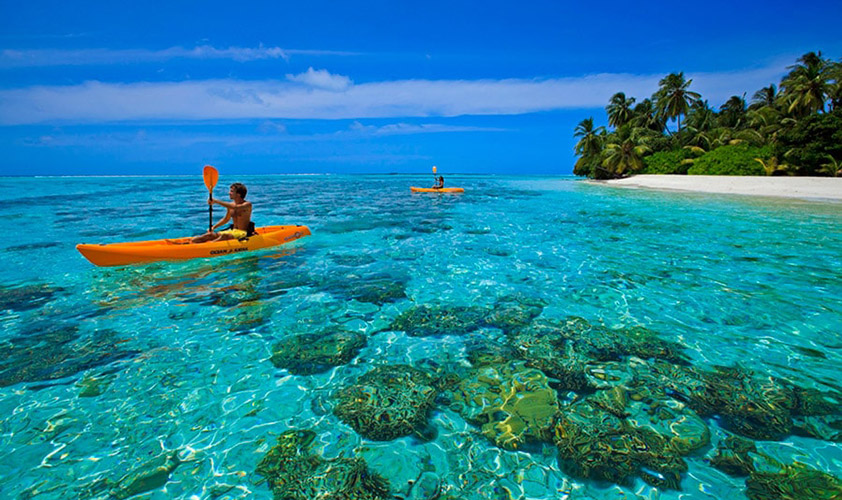
According to research of the Institute of Physics and Hydrology, the water in the area is accessible to the vessels 10 tons, and the Vietnamese government plans to build a harbour in Chan May. The harbour will be a starting point for tourists. It is planned for Chan May harbour and the Dung Quat industrial zone to greatly contribute to the economic development of central Vietnam.
Phu Cam Cathedral
The interior was built following classical traditions: two rows of stained-glass windows are located in the upper gallery and a holy cross made of steel and concrete is in the middle alley. In one of the cathedral's wings is the tomb of former archbishop Philippe Nguyen Kim Dien (1921-1988). At the front of the cathedral are two statues: Saint Phero on the right, and Saint Paulo on the left.
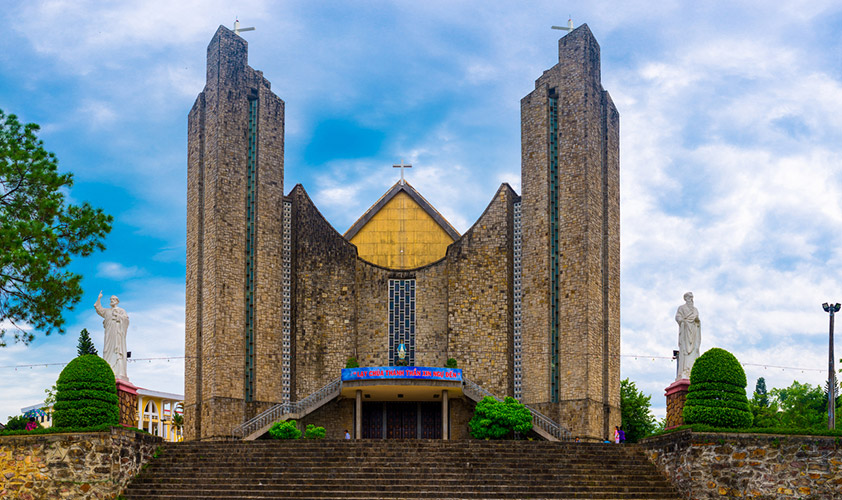
The Phu Cam Cathedral is located in Phuoc Vinh Ward, Hue City. It was built in 1965 following modern architectural designs by architect Ngo Viet Thu. New concept were used, such as the use of supporting pillars attached to walls. Three supporting pillars in each corner stretch out to create a large space for the altar.
Vi Da Village
Even today, the tourist can see along the two sides of the road to Thuan An those ancient houses, built after the classical architecture of 3 principal rooms and 2 auxiliary ones at the 2 ends, the roof is covered with "yin & yang" tiles (tiles imbricated the ones within the other), with its top having 2 dragons, in front of the house there is a courtyard paved with bricks, and a brick screen is accompanied by a rock-work (a miniature - mountain).
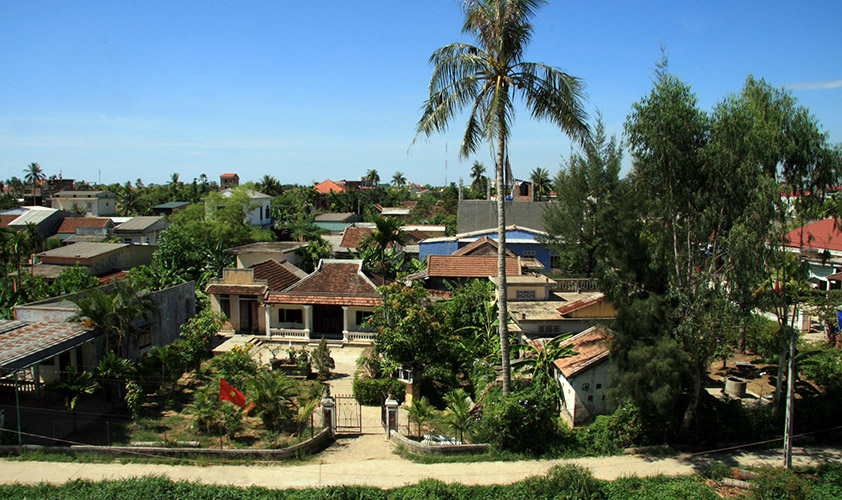
The most famous is the residence of the Prince Tuy Ly Mien Trinh, which has a three - door portico made after the architecture of Tam Quan ( 3 doors). Here is also the Ba La Mat pagoda built at the beginning of the 19th century, the communal temple of Vi Da, the Tu Bi Hi Xa pagoda...
Beside that, Vi Da is also famous for its gardening traditions, its gardens have been blossoming all year long in the 4 seasons.
Sincerely yours & see you soon!
GALATOURIST since 2005.
Testimonials

Ms. Francesca Tronconi & Mr Vizzolini Davide (2pax) from Spain

Mrs & Mr. DUPUIS (2pax) from United States

Mr. Jeffrey Szymanski (2pax) from United States

Mrs Rosemary McGuinness (2pax) from Australia

Mrs Elena Maria Sanchez (2pax) from Spain

Group Marissa (4pax) from United States

Mr Jerzy (2pax) from Canada






